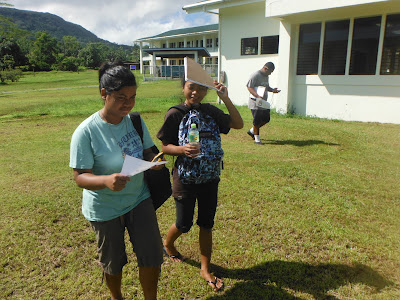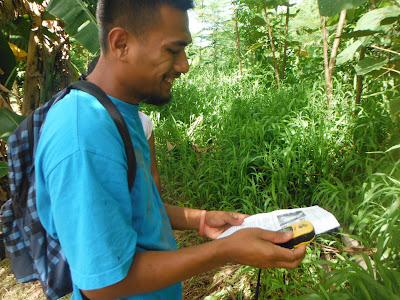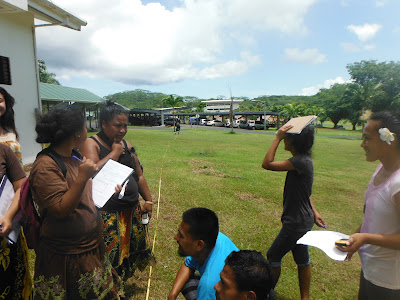Finding Binky and meters per arcminute of longitude
I hid Binky down deeper in the swale I had used last year. This year I used brown plastic shopping bags, which proved to be better camoflage down low in the paddle grass (Ischaemum polystachyum).
In the afternoon laboratory I would experiment and use the 30 m tape measure in lieu of the wheel. This made the 30 meters more clear, but it meant someone had to stay behind to bring up the other end of the tape. I had the reel on the west end, in retrospect the reel should have been east and the zero end west. That said, the other problem was that one person was left out of the data gathering, babysitting the zero end. Rotating end keepers helped.
Results compare favorably with the estimated 1842 meters per minute value for seven degrees north of the equator. The value is 39 meters low, only about 2% below the expected value.
Binky
The hide location at 6:30 in the morning
Some difference of location opinion for the GPS units.
Pwisehn malek in the early morning sun
The swale
Brown bag Binky blended right into the brown understory
Starting location for the search for Binky
Gino heads off to the left, John on the right
Joemar and Shirley-Ann head sure-footed in the right direction at a good pace
Sucy-ann, Neikaman, and Marmelyn consult the handout
Neika studies the GPS coordinates
Jason
Marsha
Mayleen compares the GPS to the coordinates on the handout
Heading west
Hansha and Mayleen
Hansha compares coordinates
Gino watching the longitude numbers roll down as he heads weast
Neikaman navigating for her group
A cat that would follow the group all the way to the hide
Cat
The cat headed west to find Binky
Joemar reaches the edge of the paddle grass sea and stops
The cat would go all the way
Neika, undeterred by the paddle grass
Marmelyn
Not children of the corn but rather physical science students deep in the paddle grass
The paddle grass is deep in the swale
At this point Mayleen and Hansha were effectively on top of my morning track, but they either were not looking for traces of track or did not know to look for track traces in paddle grass. Paddle grass stays bent for more than day where someone has walked and a good tracker could probably pick up a person's passage even two or three days later.
Neika forges ahead. She would be one of the first to reach the correct coordinates.
Gino and John coming from the west
Neika and Hansha. Hansha is very close to the Binky hide, but neither would ultimately find Binky.
Hansha and Mayleen
Much of the class converged on the coordinates. Binky is hidden in the grass off to the right.
At this point the class milled around. Only Joemar would realize that at this point the key would be to poke around in the understory.
Hansha and Mayleen
Results compare favorably with the estimated 1842 meters per minute value for seven degrees north of the equator. The value is 39 meters low, only about 2% below the expected value.












































Comments
Post a Comment